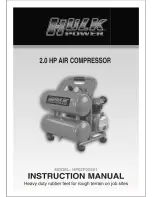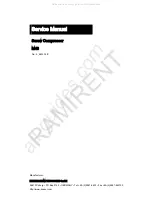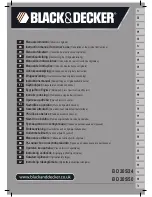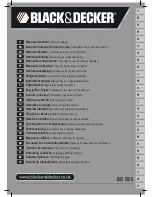
MAINTENANCE & STORAGE
TROUBLE
No start condition
Low pressure
Safety valve releasing
Oil discharge in air
POSSIBLE CAUSE
Fuse blown or circuit breaker tripped
Loose electrical connections
Overheated motor
Air leak in safety valve
Restricted air filter
Defective check valve
Defective pressure switch or improper
adjustment
Improper oil viscosity
Too much oil in crankcase
Compressor overheated
Restricted air filter
CORRECTIVE ACTION
Check voltage or eliminate extension cord or reset
Check wiring connections
Press the reset button or wait for automatic reset
Check valve manually by pulling upwards on ring. If condition
persists replace valve
Clean or replace as necessary
Replace check valve
Check for proper adjustment and if problem persists, replace
pressure switch
TROUBLE SHOOTING
MAINTENANCE
Before doing any maintenance or adjustments to your air compressor,
the following safety precautions should be taken:
-
Disconnect electrical power.
-
Drain air tank of pressure.
Daily or before each use
1. Check oil level. The oil level should be centered with the red dot
which appears in the oil sight glass (C) Fig.8.
2. Drain condensation from tank.
3. Check for any unusual noise or vibration.
4. Be sure all nuts and bolts are tight.
Monthly
1. Inspect air system for leaks by applying soapy water to all joints.
Tighten those joints if leakage is observed.
250 hours or six months (whichever comes first)
1. Change compressor oil. See following instructions.
2. Replace oil more often if compressor is used near paint spraying
operations or in dusty environments.
CHANGING OIL
To change oil, oil must be drained from the crank case by unscrewing
and removing oil sight glass (C) Fig.8. Drain oil and replace oil sight
glass. To fill the crank case with oil, first unscrew and remove oil
breather cap (A), pour air compressor oil (SAE 10W30 or SAE 10W20
weight
non-detergent compressor
oil) into crank case oil opening (B)
until the oil level reaches the red dot at the center mark of the oil
sight glass. Secure oil breather cap (A).
KEEP TOOL CLEAN
Periodically blow out all air passages with dry compressed air. Clean all
plastic parts with a soft damp cloth. NEVER use solvents to clean
plastic parts. They could possibly dissolve or otherwise damage the
material.
CAUTION: Wear safety glasses while using compressed air.
FAILURE TO START
Should your compressor fail to start, check to make sure the prongs on
the cord plug are making good contact in the outlet. Also, check for
blown fuses or open circuit breakers in the line.
STORAGE
1. Set the “ON/AUT
O-OFF”
lever to
“OFF”.
2. Turn the regulator counterclockwise to set the outlet pressure to
zero.
3. Remove the air tool or accessory .
4. Pull ring on safety valve (B) Fig. 4, allowing air to bleed from the tank,
until tank pressure is approximately 20psi. Release safety valve ring.
5. Drain water from air tank. Turn drain valve (A) Fig. 4,
counterclock-
wise, to open.
NOTE: If drain valve is plugged, pull ring on safety valve (B) Fig. 4, and
hold until air pressure has been released. The valve can then be
removed, cleaned, and reinstalled.
6. After the water has been completely drained, turn drain valve to
close. The air compressor can now be stored.
7. Store the air compressor in a clean and dry location.
FIGURE 7
7
Replace oil with SAE 10W30 or SAE 10W20
non-detergent
compressor oil. Drain crankcase and fill to proper level
Air pressure regulated too high
Replace filter
Содержание HP02P005S1
Страница 1: ......
Страница 9: ...PARTS DIAGRAM MODEL HP02P005S1 8...
Страница 11: ...937 540 1157...





























